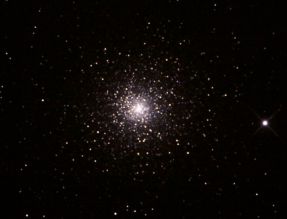 M15, Globular cluster in
Pegasus, 10/10/2010, jpeg, 140k
M15, Globular cluster in
Pegasus, 10/10/2010, jpeg, 140k
Within our own galaxy nearly 200 globular clusters are known to date, each consisting of 100 000 to a million stars. The study of theoretical models indicates they began life 10 to 15 billion years ago, when the universe was young. The globular clusters and several billion stars of low luminosity form a spherical "halo" around the galactic disk, which has a diameter of about 100 000 light-years.
Cluster stars and individual halo stars are notably deficient in elements heavier than helium, if they are compared to normal disk stars like our own sun.
No rule without exception. The Hubble-Space-Telescope (HST) has found examples of young and blue globular clusters in distant galaxies as NGC 4038/39 and NGC 1275 , were violent interaction gave birth to new stars.
 M15, Globular cluster in
Pegasus, 10/10/2010, jpeg, 140k
M15, Globular cluster in
Pegasus, 10/10/2010, jpeg, 140k
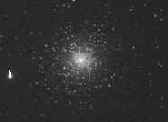 M15, Globular
cluster in Pegasus, 07/19/98, jpeg, 14k
M15, Globular
cluster in Pegasus, 07/19/98, jpeg, 14k
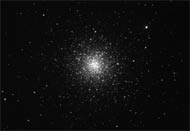 Globular
cluster M3 in Canes Venatici, 04/24/03, jpeg, 131k
Globular
cluster M3 in Canes Venatici, 04/24/03, jpeg, 131k
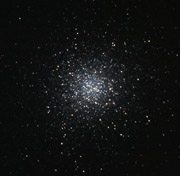 M13 Globular cluster in Hercules, 07/23/14, jpeg, 221k
M13 Globular cluster in Hercules, 07/23/14, jpeg, 221k
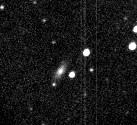 There is also this small Galaxy close to M13, designated NGC 6207
There is also this small Galaxy close to M13, designated NGC 6207
More informations about globular clusters, compiled by William E. Harris:"This catalog contains basic parameters on distances, velocities, metallicities, luminosities, colors, and dynamical parameters for 147 objects regarded as globular clusters in the Milky Way galaxy."
The images below are from July 19. After two month of rain and cloudy nights, we had some hours of a clear summer sky. The image of M15 is a single shots of 60 second integration time. Three darks of 120 seconds and a flat field (average of 7 images) were used in both cases .
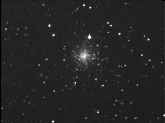 NGC 6934,
Globular cluster in Delphinus, 07/19/98, jpeg, 13k
NGC 6934,
Globular cluster in Delphinus, 07/19/98, jpeg, 13k
The following image shows M2 in the night of August 19th, 1998.
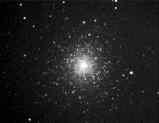 M2, Globular cluster,
08/19/98, jpeg, 24k
M2, Globular cluster,
08/19/98, jpeg, 24k
The image below was made in France, May 16, 1999.
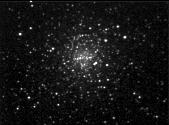 M4,
Globular cluster in Scorpius, 05/16/99, 8" f/4.6, jpeg, 37k
M4,
Globular cluster in Scorpius, 05/16/99, 8" f/4.6, jpeg, 37k
The images below were made in France, May 24, 1999.
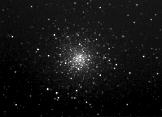 m10
m10
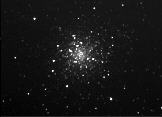 m12
m12
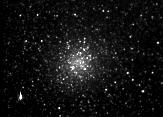 m22
m22
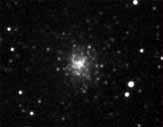 Palomar 2, Globular cluster in
Auriga,02/20/03, 10" f/4.6,ST8E,jpeg,76k
Palomar 2, Globular cluster in
Auriga,02/20/03, 10" f/4.6,ST8E,jpeg,76k
Meanwhile it is widely known, that globular clusters in other galaxies are also in the reach of amateur instruments. It is not too difficult to observe the most luminous ones in M31 with your own eyes. Look for the indicated positions on my special page about the Andromeda Galaxy.
Comments welcome, contact:
